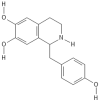A Narrative Review on Higenamine: Pharmacological Properties and Clinical Applications
- PMID: 40290051
- PMCID: PMC11944829
- DOI: 10.3390/nu17061030
A Narrative Review on Higenamine: Pharmacological Properties and Clinical Applications
Abstract
Background: Higenamine, a bioactive alkaloid derived from plants such as Aconitum and Annona squamosa, has been traditionally used in Chinese medicine for treating heart diseases like bradycardia, arrhythmia, and heart failure. It exhibits multiple pharmacological effects, including anti-oxidative stress, improved cellular energy metabolism, anti-apoptosis, and enhanced erectile dysfunction.
Aim and methods: To investigate the reasons for these functions of higenamine and its application in the clinic, the literature of the database was searched and read in this study.
Results: As a non-selective β-agonist, higenamine activates both β1- and β2-adrenergic receptors, leading to cardiovascular benefits such as increased heart rate and myocardial contractility, as well as bronchodilation. It has also been studied for its potential in weight loss, anti-inflammatory properties, and antioxidant properties, with applications in treating asthma, cardiovascular diseases, and ischemia-reperfusion injuries. However, its clinical use is limited by the need for further research on its long-term safety, pharmacokinetics, and interactions with other drugs. Despite its promising therapeutic potential, higenamine's inclusion in the World Anti-Doping Agency's banned list highlights concerns over its stimulant effects and safety in athletic contexts.
Conclusions: Future studies should focus on optimizing its clinical applications while ensuring safety and efficacy. In terms of clinical applications, future research will also be able to explore more possibilities to use higenamine more in the treatment of diseases.
Keywords: PI3K/Akt signaling pathway; anti-doping; anti-inflammatory; antioxidant; cardiovascular protection.
Conflict of interest statement
The authors declare no conflicts of interest.
Figures



References
Publication types
MeSH terms
Substances
LinkOut - more resources
Full Text Sources
Research Materials

